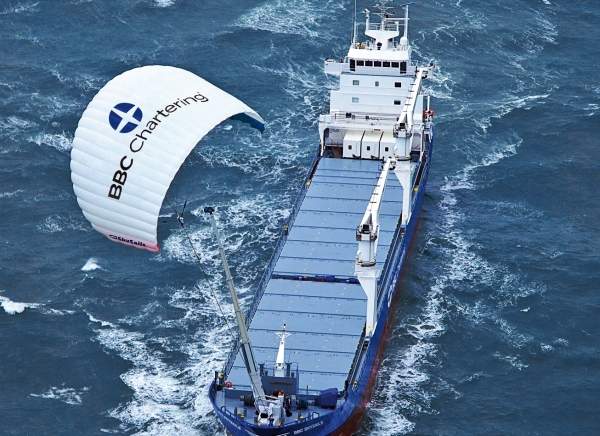

Winner – SkySails
Consisting of three main components: a towing kite with rope, a launch and recovery system and a control system for automated operation, SkySails’ patented design makes use of the cheapest and most powerful source of energy at sea – the wind.
So persuasive is the potential of this particular technology that for the first time wind propulsion will be taken into account when computing the Marine Environment Protection Committee’s Energy Efficiency Design Index (EEDI) for 2013.
To read our feature article with SkySails click here.
2013 Nominees
Eco Marine Power – Aquarius MRE

The Aquarius MRE System is an advanced integrated system of rigid sails, solar panels and energy storage modules designed to harness both wind and solar power. First released in 2012, the company has forged ahead in 2013 through a serious of partnerships demonstrating the company’s relentless pursuit of innovation throughout the entire MRE ecosystem.
Deals include a partnership with Solbian Energie Alternative Srl of Italy to focus on incorporating their technology into EMP’s EnergySail – a configurable rigid sail that is able to tap into the power of the wind and sun. And most recently the company established a deal with KEI System Ltd (KEI) of Osaka, Japan, for development of the Aquarius Monitoring and Automation System, or Aquarius MAS – a marine computer system capable of monitoring and/or controlling equipment on ships, including wind and solar power devices.
Duke University – hull coatings

Duke University engineers have developed a polymer that can prevent fouling on ships’ hulls by twitching, creasing and wrinkling. Taking inspiration from the same barnacles and bacteria that cause the problem in the first place, unlike most other hull coatings this approach is entirely non-toxic.
The technology has been tested with good results in the laboratory and researchers are now working on reducing cost and longevity of the material, which has already received serious interest from an industry keen to save millions on down time and fuel-drag.
Corvus Energy – Prinsesse Benedikte

At the end of July 2013, the 124m Prinsesse Benedikte – the largest hybrid vessel ever built, nicknamed the “Prius of the Sea” – is anticipated to go live with her new hybrid system on Denmark’s Rødbyhavn to Puttgarden route.
Powered by Vancouver-based Corvus Energy’s advanced lithium polymer battery solution, it will reduce maintenance costs, fuel consumption, greenhouse gas emissions and noise production, while increasing revenue and technical efficiency. If it floats, and we’re certain it will, the Prinsesse Benedikte will set the benchmark for innovation in hybrid passenger vessels.
DNV & PSE – On-board CCS

In February 2013 Det Norske Veritas (DNV) and Process Systems Enterprise Ltd. (PSE), announced that their joint Maritime CCS (carbon capture and storage) research and development project successfully developed a concept design for on-board chemical CO2 capture. The results show that the concept is technically feasible and capable of reducing ship CO2 emissions by up to 65%.
For a VLCC tanker, this could correspond to capturing more than 70,000t of CO2 yearly, directly transforming emissions to a tradable product. Financed by the UK’s Technology Strategy Board and the Research Council of Norway under the EUROSTARS initiative, the design captures liquid CO2 until it can be discharged into transmission and storage infrastructures at the next suitable port.
Maersk – Triple E

Launched in July 2013 in Okpo, South Korea, the Mærsk Mc-Kinney Møller, is the largest ship ever built. The first of the Triple- E Class, the vessel sets new standards in the container industry, not only because of its epic size, but also because of a unique design which ensures the vessel emits 50% less CO2 per container moved than the current average on the Asia-Europe route.
The Triple-E will also consume approximately 35% less fuel per container than comparable ships, a true feat of sustainability design and engineering.
Related content
Project Martha: reducing seafarer fatigue
With 90% of global trade carried out by sea, shipping is recognised as the ultimate 24/7 industry.
Web of intrigue: protecting ports against cyber-terrorism
A cyber attack by drug traffickers at the Belgian port of Antwerp has focused attention on security at the world’s maritime gateways.



